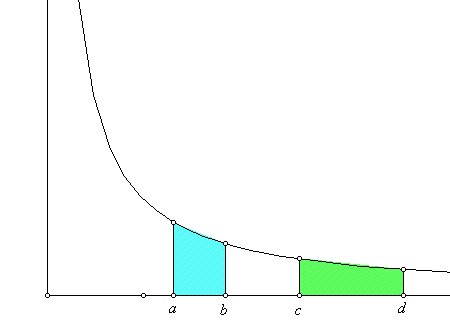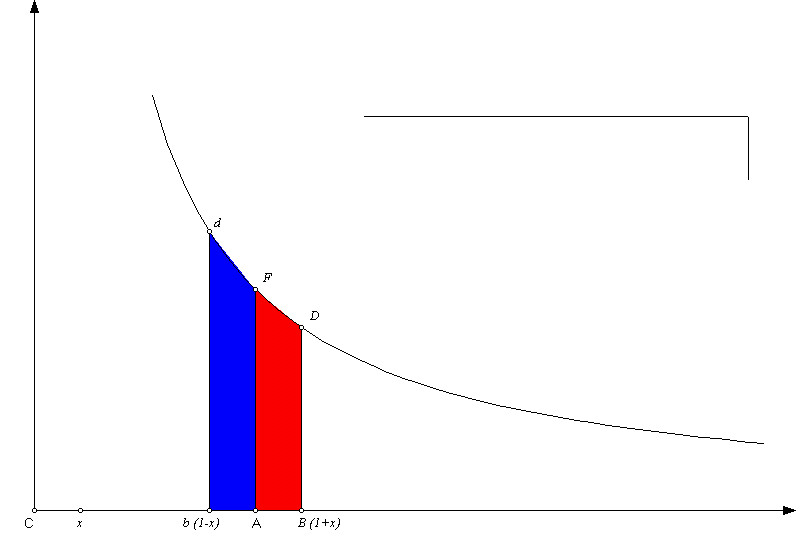
Problem II: Taylor / Maclaurin Polynomial Estimate for An Important Integral from Probability
What is the area of the region in the plane bounded by the X-axis, X=0, X=0 and `Y = e^{-X^2}`? or
what is `int_0^1 e^{-x^2} dx` ?


In 1637, Descartes published La Geometrie as an appendix to his Discours de la Methode. This started the investigation of geometry using arithmetic and algebra through common measurments, coordinates, and equations that described curves.By about 1640, the solution to the "area problem" for curves with equation Y n = aX m was known by Fermat for all integer cases except when n = 1, m = -1.
I.e., the only unsolved area problem was for Y = 1/X - the standard equation for the graph of a hyperbola.
In 1647, Gregoire de St. Vincent showed the following special property for hyperbolas:
Proposition 1: If a/b = c/d then the area under the hyperbola above the interval [a,b] is equal to the area under the hyperbola above the interval [c,d].

The proof of this may be discussed if time permits. You can try it as an exercise in integration substitution.
In 1649 Alfonso Antonio de Sarasa recognized this feature in Gregoire's work and connected it to the properties of logarithms.
In particular he recognized the following additive property of these measurements which had previously be a key feature in the study of common logarithms (base 10):
Proposition 2: If the areas are all measured using a = 1, then
the area determined by a product of two numbers , rs, is equal to the sum of the areas determined by r and s separately.
Here's why:
We can see easily that `1/r =s/{rs}`.
So by Proposition 1 the area under the hyperbola above the interval [1,r] is equal to the area under the hyperbola above the interval [s,rs].
But the area under the hyperbola above the interval [1,rs] can be cut into two pieces above the intervals [1,s] and [s ,rs]. so the area determined by a product of two numbers , rs, is equal to the sum of the areas determined by r and s separately.

Now Newton uses the first eight terms with h = .1 (and .2) to estimate the hyperbolic log of .9 and 1.1 (as well as .8 and 1.2).
| h | 0.1 | .2 | .01 |
| 2h | 0.2 | 0.4 | 0.02 |
| 2h3/3 | 0.000666666666666 | 0.00533333333333 | 0.00000066666666667 |
| 2h5/5 | 0.000004 | 0.000128 | 0.00000000004 |
| 2h7/7 | 0.0000000285714286 | 0.00000365714285714 | 0.00000000000000286 |
| 2h9/9 | 0.0000000002222222 | 0.00000011377777778 | 2.22222222222e-19 |
| 2h11/11 | 0.0000000000018182 | 0.00000000372363636 | |
| 2h13/13 | 0.0000000000000154 | 0.00000000012603077 | |
| 2h15/15 | 0.0000000000000001 | 0.00000000000436907 | |
| T=Sum of Areas | 0.200670695462151 | 0.405465108108002 | 0.020000666706670 |
| h | 0.1 | .2 | .01 |
| h2 | 0.01 | 0.04 | 0.0001 |
| h4/2 | 0.00005 | 0.0008 | 0.000000005 |
| h6/3 | 0.0000003333333333 | 0.00002133333333 | 0.000000000000333 |
| h8/4 | 0.0000000025 | 0.00000064 | 2.50000000000e-17 |
| h10/5 | 0.00000000002 | 0.00000002048 | |
| h12/6 | 0.0000000000001667 | 0.00000000068267 | |
| h14/7 | 0.0000000000000014 | 0.00000000002341 | |
| Diff'ce of Areas | 0.010050335853501 | 0.040821994519406 | 0.000100005000333 |
Thus ln(1.1)= 1/2 ( 0.2006706954621511- 0.0100503358535014)
= 0.0953101798043248
while ln(.9) = -(1/2)( 0.2006706954621511 + 0.0100503358535014)
= -0.105360516578263 .
And ln(1.2)= 1/2 (0.405465108108002 -0.040821994519406 )
= 0.18232155576939546 (from Newton)
while ln(.8) = -(1/2)(0.405465108108002 +0.040821994519406 )
= -0.2231435513142097 (from Newton) .
Newton can also find ln(1.01) and ln(.99) by using h=.01
from the same tables.
Then Newton finds other logarithms with great accuracy
using these.
In particular Newton calculates the estimate for
ln(2) = ln ( 1.44 / .72) = ln (1.44)-ln(.72) = 2ln(1.2) -[ln(.9 +ln(.8)]
= (approx) 2(0.18232155576939546) +0.105360516578263+ 0.2231435513142097
